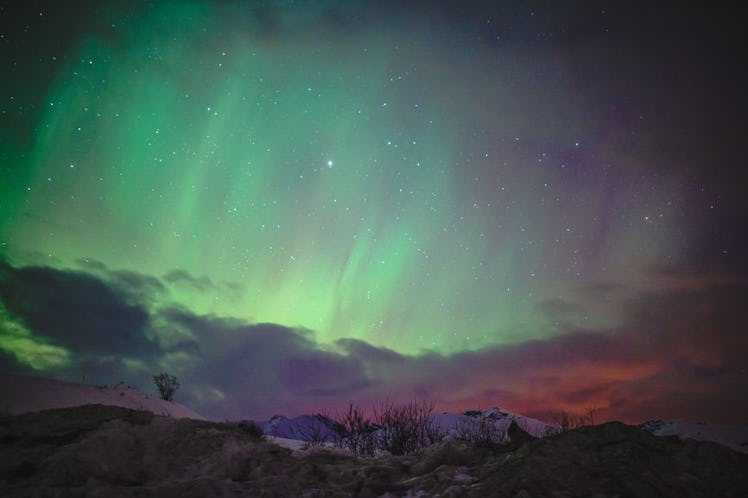
People In The U.S. Can See The Northern Lights Tonight If They Watch At This Time
If seeing the Northern Lights isn't currently on your summer bucket list, it should be. The whimsical blend of multicolored lights will adorn the night sky in parts of the United States before the end of June, and you don't want to miss out on seeing it for yourself. The evening light show doesn't come around often, so make sure to clear your schedule before the big event. So, when is this all going down? Here's when to see the Northern Lights in the United States in June 2018.
If you look up at the sky on the night of June 27 (and into the morning of June 28), you may be lucky enough to catch a glimpse of Aurora Borealis, also known as the Northern Lights, from your backyard. The dark sky will be filled with luminous colors from the Northern Lights on the night of Wednesday, June 27, according to the Space Weather Prediction Center. This is all because of a G1 geomagnetic storm that started on Tuesday, June 26. The storm will last through the early morning hours of Thursday, June 28, according to SWPC. Don't worry — the storm is not as intense as it sounds. Geomagnetic storms are measured on a scale of G1 to G5, so this one is relatively minor.
When should you head outside to see the unique light show with your own two eyes? Set your alarm clocks, because you won't be able to see the Northern Lights until the wee hours of 2 a.m. ET on Thursday, June 28, according to Thrillist. The bright night sky will light up for about three hours, so if 2 a.m. is too early for you, you've got until 5 a.m. ET to see the Northern Lights for yourself. It is possible that you may be able to observe the Northern Lights in the hours leading up to 2 a.m., but that early morning window is going to be your best chance. The timing for the Northern Lights may shift between now and then, so be sure to check with the National Oceanic and Atmospheric Administration for the latest updates.
Sadly, the Northern Lights won't be visible for everyone across the nation to see. For instance, if you live in the southern United States, you will be too far away to see the Northern Lights. For minor geomagnetic storms like this one, the Northern Lights are most visible at high northern elevations in the United States, and, more specifically, in locations like Michigan and Maine as long as the sky is clear, according to SWPC.
In the early morning hours (like what you might see on Thursday, June 28), the Northern Lights appear to look more like soft, pillowy clouds than your average light formations. Typically, the Northern Lights appear in a range of colors such as pink, green, yellow, blue, violet, and occasionally orange and white, according to Space.com. The unique appearance is part of what makes them so appealing to people around the world — myself included.
This round of Aurora Borealis is shaping up to be a beautiful event, so hit the hay a little earlier than normal tonight. This way you can avoid the middle-of-the-night grogginess and enjoy the view. Personally, I've never had the privilege of viewing the Northern Lights, but it is on my to-do list. Based on pictures of the spectacular event, I know I am missing out big time. Where else can you find such a pretty array of colors in the nighttime sky? The best time to see the Northern Lights is usually in winter or spring, according to Space.com, so I may just put my trip on hold until later this year for optimal viewing.